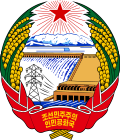利用者:Sinhako/永遠の共和国主席
共和国の永遠なる主席 공화국의 영원한 주석 | |
|---|---|
 | |
 | |
| 呼称 | 閣下 |
| 庁舎 | |
| 根拠法令 | 朝鮮民主主義人民共和国社会主義憲法 |
| 前身 | 国家主席 |
| 創設 | 1998年9月5日 |
| 初代 | 金日成 |
| 最後 | 金日成 |
| 廃止 | 2012年4月13日 |
| 継承 | 主体朝鮮の永遠なる領袖 |
主体朝鮮の永遠なる領袖 주체조선의 영원한 수령 | |
|---|---|
 | |
 | |
| 庁舎 | |
| 所在地 | |
| 根拠法令 | 朝鮮民主主義人民共和国社会主義憲法 |
| 創設 | 1972年12月28日 (国家主席) 1998年9月5日 (共和国の永遠なる主席) 2012年4月13日 (主体朝鮮の永遠なる領袖) |
| 永遠の共和国主席 | |
|---|---|
| 各種表記 | |
| ハングル: | 공화국의 영원한 주석 |
| 漢字: | 共和國의 永遠한 主席 |
| 発音: | コンファグクニ ヨンモファン チュソク |
| 日本語読み: | きょうわこくのえいえんなるしゅせき |
| RR式: |
Gonghwagugui Yeongwonhan Juseok |
| MR式: |
Konghwagugŭi Yŏngwŏnhan Chusŏk |
| 英語表記: | Eternal President of the Republic |
The official designation of an Eternal President of the Republic (공화국의 영원한 주석, literally in English "Eternal Chairman of the Republic") was established by a line in the preface to the Constitution of the Democratic People's Republic of Korea, as amended on September 5, 1998, and in subsequent revisions.
It reads (in the original version):
According to Ashley J. Tellis and Michael Wills, this amendment to the preamble is an indication of the unique North Korean characteristic of being a theocratic state based on a cult of personality revering Kim Il-sung. In addition, North Korea adopted a Juche calendar dating from 1912, the year of Kim Il-sung's birth.[2]
Presidency of North Korea
[編集]The President of the Democratic People's Republic of Korea was established in the Constitution of North Korea in 1972. Until then, Kim Il-sung, the de facto ruler of North Korea, held the posts of Premier and General Secretary of the Workers' Party of Korea.
In 1972 the Presidency was established, and Kim Il-sung was elected to the position by the Supreme People's Assembly, the North Korean legislature, on 28 December 1972. Kim held the Office of President until 1994 when he died, and the position was left vacant when he died.
The revised constitution in 1998 abolished the presidency and established the honorific title of Eternal President of the Republic, which was given to Kim Il-sung.
Head of state role in North Koreas after 1994
[編集]Template:Currentyear年現在[update] there is no President of North Korea, as the office was left vacant from the death of Kim Il-sung in 1994, and was ipso facto abolished with the 1998 constitutional changes.
Instead, the functions and powers previously belonging to the President were divided between three officials: the head of government, the Premier of North Korea; the speaker of the legislature, the Chairman of the Presidium of the Supreme People's Assembly; and the head of the military, the Chairman of the National Defence Commission (replaced by State Affairs Commission of North Korea in 2016) and Supreme Commander of the Korean People's Army, currently held by Kim Il-sung's grandson, Kim Jong-un.
The latter Kim is also the chairman of the Workers' Party of Korea, and is reckoned as "Supreme Leader" with absolute control over the country.
See also
[編集]- Death and state funeral of Kim Il-sung
- Family dictatorship
- Imperial cult
- Kim dynasty (North Korea)
- Kim Il-sung bibliography
- List of things named after Kim Il-sung
- North Korean cult of personality
- Political religion
- President for Life
- Propaganda in North Korea
- Sacred king
脚注
[編集]- ^ 朝鮮民主主義人民共和国社会主義憲法 (1998年版)
- ^ Ashley J. Tellis; Michael Wills (30 September 2007). Domestic Political Change and Grand Strategy. NBR. p. 128. ISBN 978-0-9713938-8-2 9 July 2012閲覧。
外部リンク
[編集]- 金正日 (1994). 偉大な領袖金日成同志をわが共和国の永遠なる主席として高くいただこう



